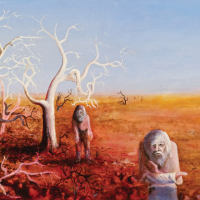54. DAVID BOYD

In the growth and transformation of its myths a society achieves its own sense of identity The ways in which a society images its own feelings and attitudes in myth provides him with one of the deepest sources of art.1
One of the eight Melbourne painters to join art critic Bernard Smith in defence of the figurative image and the right to draw inspiration from our own lives and those about us,2 David Boyd was a vigorous participant in the Antipodean affair of 1958-59. Indeed, almost contemporary with Sidney Nolans celebrated Kelly series, Albert Tuckers desert paintings and Arthur Boyds Brides, he embarked upon his controversial Truganini series of which the present work The Last Tree 1958 is an important example. Following his infamous Explorer sequence which had heralded his stormy transition from potter to painter during the late 1950s, this theme derived its inspiration from the story of the Tasmanian Aborigines, and specifically the tragedy of Truganini, the last of the Aborigines.
Just as his Explorer paintings had been scorned as either parodies or plagiarisms,3 so too sadly David Boyds empathy with the plight of the Aboriginal people was met with hostility and derision. In particular, Robert Hughes, writing dismissively of the Antipodeans departure for London, found a reasy target in works such as the present: David Boyds bug-eyed Abos have gone walkabout to W.1 (bigfella humanism belonga him mythmaker, as they say in South Ken) so that even the comic relief is missing.4 Ironically, the joke now seems to be on Hughes, with David Boyd today acclaimed as ahead of his time for confronting the Aboriginal tragedy. As Bernard Smith elucidated at the time in an impassioned plea to critics to reassess their condemnation of David Boyds vision:
the last works of the Tasmanian Aboriginal series are an achievement of real magnitude in recent Australian painting. The anecdotal element has been suppressed. The forms are cubic, simple and massive, and the trend is towards classicism of expression. In the process of creating this series the Tasmanian tragedy has grown into a universal expression of the conflict between white and coloured. These paintings belong to the world of the Notting Hill riots, Little Rock and Sharpeville, the Stuart case, and the trial of Albert Namatjira. They are concerned with human conflict, guilt, love, compassion and forgiveness, and what they express is expressed as painting, not as literature or propaganda.5
Footnotes
1. Smith, B., Australian Painting 1788-1960, Oxford University Press, Melbourne, 1962, p.315
2. ibid.
3. Laurie Thomas cited in Sun (Sydney), 1 October 1958, p.28
4. Robert Hughes cited in Nation, 23 March 1963
5. Smith, B., David Boyd in Adelaide, Nation, 18 June 1960, p.17
Staff Writer